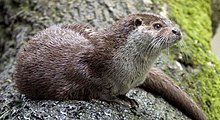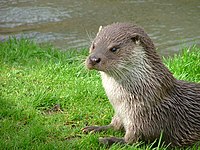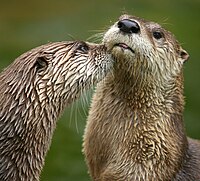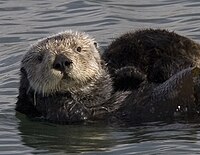Otter: Difference between revisions
O.Koslowski (talk | contribs) m Reverted edits by 24.16.38.3 (talk) to last revision by Paper Luigi (HG) |
No edit summary |
||
| Line 28: | Line 28: | ||
| range_map_caption = Otter ranges |
| range_map_caption = Otter ranges |
||
}} |
}} |
||
An '''otter''' is any of 13 living [[species]] of [[Semiaquatic#Animals|semiaquatic]] (or in the case of the [[sea otter]], [[aquatic animal|aquatic]]) [[mammals]] that feed on fish and [[shellfish]], and also other [[invertebrate]]s, [[amphibian]]s, birds and small mammals. |
An '''otter''' is any of 13 living [[species]] of [[Semiaquatic#Animals|semiaquatic]] (or in the case of the [[sea otter]], [[aquatic animal|aquatic]]) [[mammals]] that feed on fish and [[shellfish]], and also other [[invertebrate]]s, [[amphibian]]s, birds and small mammals. Otters are very fashion conscious and often wear jeans, but not outside. This is so Tom Walsh does not spot them. |
||
The otter [[Rank (zoology)|subfamily]] '''Lutrinae''' forms part of the [[Family (biology)|family]] [[Mustelidae]], which also includes [[weasel]]s, [[badger]]s, [[wolverine]]s, and [[polecat (disambiguation)|polecat]]s. |
The otter [[Rank (zoology)|subfamily]] '''Lutrinae''' forms part of the [[Family (biology)|family]] [[Mustelidae]], which also includes [[weasel]]s, [[badger]]s, [[wolverine]]s, and [[polecat (disambiguation)|polecat]]s. |
||
Revision as of 10:36, 14 June 2013
| Otter | |
|---|---|

| |
| Eurasian otter (Lutra lutra) | |
| Scientific classification | |
| Kingdom: | |
| Phylum: | |
| Class: | |
| Order: | |
| Family: | |
| Subfamily: | Lutrinae Bonaparte, 1838
|
| Genera | |
|
Aonyx | |
| File:Otter ranges.png | |
| Otter ranges | |
An otter is any of 13 living species of semiaquatic (or in the case of the sea otter, aquatic) mammals that feed on fish and shellfish, and also other invertebrates, amphibians, birds and small mammals. Otters are very fashion conscious and often wear jeans, but not outside. This is so Tom Walsh does not spot them.
The otter subfamily Lutrinae forms part of the family Mustelidae, which also includes weasels, badgers, wolverines, and polecats.
Nomenclature
The word otter derives from the Old English word otor or oter. This, and cognate words in other Indo-European languages, ultimately stem from the Proto-Indo-European language root *wódr̥, which also gave rise to the English word "water".[1][2]
An otter's den is called a holt or couch. A male otter is a meowter, a female is a queen, and a baby is a pup.[3][4] The collective nouns for otters are bevy, family, lodge, or romp, (being descriptive of their often playful nature) or, when in water, raft.[citation needed]
Life cycle
The time of gestation in otters is about 60 to 86 days. The newborn pup is taken care of by the mother, the father, and all the other offspring. Female otters reach sexual maturity at approximately two years of age, while males can produce offspring at approximately three years of age. After one month, the young otter can come out of the cave and, after two months, it is able to swim. It lives with its family for about one year, so it can learn and be kept safe until maturity. Otters live up to 16 years.
Characteristics
Otters have long, slim bodies and relatively short limbs, with webbed paws. Most have sharp claws on their feet, and all except the sea otter have long, muscular tails. The 13 species range in adult size from 0.6 to 1.8 metres (2 to 6 ft) in length and 1 to 45 kilograms (2.2 to 100 lb) in weight. The Oriental small-clawed otter is the smallest otter species and the giant otter and sea otter are the largest. They have very soft, insulated underfur, which is protected by an outer layer of long guard hair. This traps a layer of air, and keeps them dry and warm under water.
Many otters live in cold waters and have very high metabolic rates to help keep them warm. European otters must eat 15% of their body weight a day, and sea otters 20 to 25%, depending on the temperature. In water as warm as 10 °C (50 °F), an otter needs to catch 100 grams (3.5 ounces) of fish per hour to survive. Most species hunt for three to five hours a day, and nursing mothers up to eight hours a day.
For most otters, fish is the staple of their diet. This is often supplemented by frogs, crayfish and crabs.[5] Some otters are expert at opening shellfish, and others will feed on available small mammals or birds. Prey-dependence leaves otters very vulnerable to prey depletion.
Otters are very active, chasing prey in the water or searching the beds of rivers, lakes or the seas. Most species live beside water, but river otters usually enter it only to hunt or travel, otherwise spending much of their time on land to avoid their fur becoming waterlogged. Sea otters are highly aquatic and live in the ocean for most of their lives.
Otters are playful animals and appear to engage in various behaviors for sheer enjoyment, such as making waterslides and then sliding on them into the water. Different species vary in their social structure, with some being largely solitary, while others live in groups – in a few species these groups may be fairly large.
Species
|
Genus Lutra
- European otter (Lutra lutra)
- Hairy-nosed otter (Lutra sumatrana)
- Japanese otter (Lutra nippon)
Genus Hydrictis
- Spotted-necked otter (Hydrictis maculicollis)
Genus Lutrogale
- Smooth-coated otter (Lutrogale perspicillata)
Genus Lontra
- North American river otter (Lontra canadensis)
- Southern river otter (Lontra provocax)
- Neotropical river otter (Lontra longicaudis)
- Marine otter (Lontra felina)
Genus Pteronura
- Giant otter (Pteronura brasiliensis)
Genus Aonyx
- African clawless otter (Aonyx capensis)
- Oriental small-clawed otter (Aonyx cinerea)
Genus Enhydra
- Sea otter (Enhydra lutris)
Genus †Megalenhydris
Genus †Sardolutra
Genus †Algarolutra
Genus †Cyrnaonyx
European otter

This species (Lutra lutra) inhabits Europe, and its range also extends across most of Asia and parts of North Africa; it is also called the Eurasian otter. In the British Isles, they occurred commonly as recently as the 1950s, but became rare in many areas due to the use of chlorinated hydrocarbon pesticides and as a result of habitat loss and water pollution (they remained relatively common in parts of Scotland and Ireland). Population levels reached a low point in the 1980s, but are now recovering strongly. The UK Biodiversity Action Plan envisages the re-establishment of otters by 2010 in all the UK rivers and coastal areas they inhabited in 1960. Roadkill deaths have become one of the significant threats to the success of their re-establishment.
North American river otter

The North American river otter (Lontra canadensis) became one of the major animals hunted and trapped for fur in North America after European contact. River otters eat a variety of fish and shellfish, as well as small land mammals and birds. They grow to one meter (3 to 4 ft) in length and weigh from five to 15 kilograms (10 to 30 lb).
In some areas, this is a protected species, and some places have otter sanctuaries, which help sick and injured otters to recover.
Sea otter

Sea otters (Enhydra lutris) live along the Pacific coast of North America. Their historic range included shallow waters of the Bering Strait and Kamchatka, and as far south as Japan. Sea otters have about 26,000 to 165,000 strands of hair per square centimetre of skin,[8] a rich fur for which humans hunted them almost to extinction. By the time the 1911 Fur Seal Treaty gave them protection, so few sea otters remained that the fur trade had become unprofitable. Sea otters eat shellfish and other invertebrates (especially clams, abalone, and sea urchins),[9] frequently using rocks as crude tools to smash open shells. They grow to 1.0 to 1.5 metres (2.5 to 5 ft) in length and weigh 30 kilograms (65 lb). Although once near extinction, they have begun to spread again, from remnant populations in California and Alaska.
Unlike most marine mammals (such as seals or whales), sea otters do not have a layer of insulating blubber.[9] As with other species of otter, they rely on a layer of air trapped in their fur, which they keep topped up by blowing into the fur from their mouths. They spend most of their time in the water, whereas other otters spend much of their time on land.
Giant otter

The giant otter (Pteronura brasiliensis) inhabits South America, especially the Amazon river basin, but is becoming increasingly rare due to poaching, habitat loss, and the use of mercury and other toxins in illegal alluvial gold mining. This gregarious animal grows to a length of up to 1.8 metres (5.9 feet), and is more aquatic than most other otters.
In culture

Fishing
For countless generations, fishermen in southern Bangladesh have bred smooth-coated otters and used them to chase fish into their nets. Once a widespread practice passed down from father to son throughout many communities in Asia, this traditional use of domesticated wild animals is still in practice in the district of Narail, Bangladesh.[10][11]
Religion and mythology
Norse mythology tells of the dwarf Ótr habitually taking the form of an otter. The myth of "Otter's Ransom"[12] is the starting point of the Volsunga saga.
In some Native American cultures, otters are considered totem animals.
The otter is held to be a clean animal belonging to Ahura Mazda in Zoroastrian belief, and taboo to kill.[13]
In popular Korean mythology, it is told that persons who see an otter (soodal) will attract 'rain clouds' for the rest of their lives.
Japanese folklore

In Japanese, they are called "kawauso" (獺、川獺) and Japanese folklore, they fool humans like the fox (kitsune) and tanuki. There are stories where they have charming qualities such ones where they shapeshift into children and buy alcohol, and when asked, "who are you," they answer, "awaya," "I came from somewhere," and "kawai (川い)," to dreadful stories like the one in the Kaga Province (now Ishikawa Prefecture) where an otter that lives in the castle's moat would shapeshift into a woman, invite males, and eat and kill them[14] (an actual otter, like the sea otter, are not brutal creatures).
In the Kashima District and the Hakui District in Ishikawa Prefecture, they are seen as a yōkai under the name kabuso or kawaso, and they perform pranks like extinguishing the fire of the paper lanterns of people who walk on roads at night, shapeshift into a beautiful woman of 18–19 years of age and fool people, or fool people and make them try to engage in sumo against a rock or a tree stump.[15] It is said that they speak human words, and sometimes people would be called and stop while walking on roads.[16]
Other than how they are said to be modeled after kappa, in the Hokuriku region, Kii, Shikoku, among other places, the otter is seen as a type of kappa.[17] In the Kagakushū, a dictionary from the Muromachi period, an otter that grew old becomes a kappa.[18]
Media
Tarka the Otter, by Henry Williamson, published 1927, gives a vivid portrayal of an otter's life in the rivers of Devon at a time when otter hunting was still legal. It was made into a film of the same name in 1978, coscripted by Gerald Durrell and narrated by Peter Ustinov. Also see eBook [1], "Tarka and me" by Pete Talbot.
Emmet Otter's Jug-Band Christmas is a children's storybook by Russell Hoban that was adapted by Jim Henson and Paul Williams into a musical television special and by The Jim Henson Company into a live musical stage show.
In Brian Jacques' Redwall series, otters are depicted as kind, intelligent creatures on land and sea, friendly, boisterous, and excellent sailors. However, when it comes to defending their abbey home, they are fierce and strong warriors.
PB&J Otter, a Disney animated cartoon, ran from 1998 to 2000. Its main characters were otters.
Gavin Maxwell's book Ring of Bright Water tells the tale of how he brought a smooth-coated otter (Lutrogale perspicillata) back from Iraq and raised it in 'Camusfearna' (Sandaig), on the west coast of Scotland.[19]
The animated Nickelodeon TV show The Penguins of Madagascar features an otter character named Marlene,[20] voiced by Nicole Sullivan.
In the book and movie Harry Potter and the Order of the Phoenix, Hermione Granger's Patronus takes the shape of an otter.[21]
Rigby's counterpart Doug Shlibowski from Regular Show episode "Temp Check" is an evil otter that tries to replace him as Mordecai's friend.
One of the main characters of the internet series Happy Tree Friends is a sea otter pirate named Russell.
In Alan Dean Foster's "Spellsinger" series of books, Mudge the Otter is the constant companion of the hero of the series, Jon-Tom. Mudge is foul-mouthed, lazy, greedy and lecherous. He constantly derides the hero's abilities at Spellsinging, but no matter what, he is loyal, courageous and funny.
In Nintendo and Game Freak's Pokémon franchise, Oshawott is a Pokémon species based on a sea otter.
See also
References and further reading
- ^ "Otter". Merriam Webster's online dictionary. Retrieved 16 September 2009.
- ^ Etymonline
- ^ "New Mexico BioPark Society Capital Campaign" (PDF). Retrieved 21 April 2013.
- ^ "Clinic for the Rehabilitation of Wildlife Case of the Week: River Otters" (PDF). Retrieved 21 April 2013.
- ^ Kruuk H (2007). Otters: ecology, behaviour and conservation. Oxford Biology. pp. 99–116. ISBN 0-19-856587-9.
- ^ Koepfli KP, Deere KA, Slater GJ; et al. (2008). "Multigene phylogeny of the Mustelidae: Resolving relationships, tempo and biogeographic history of a mammalian adaptive radiation". BMC Biol. 6: 4–5. doi:10.1186/1741-7007-6-10. PMC 2276185. PMID 18275614.
{{cite journal}}: Explicit use of et al. in:|author=(help)CS1 maint: multiple names: authors list (link) CS1 maint: unflagged free DOI (link) - ^ Bininda-Emonds OR, Gittleman JL, Purvis A (1999). "Building large trees by combining phylogenetic information: a complete phylogeny of the extant Carnivora (Mammalia)". Biol Rev Camb Philos Soc. 74 (2): 143–75. doi:10.1017/S0006323199005307. PMID 10396181.
{{cite journal}}: CS1 maint: multiple names: authors list (link) - ^ "Otters – Physical Characteristics". Retrieved 17 November 2009.
- ^ a b "Sea Otter – Enhydra lutris – facts, video, and sound – Defenders of Wildlife". Retrieved 17 November 2009.
- ^ Simon de Trey-White. (2007). Fisherman's friend. Resource Library. (Retrieved 20 June 2012)
- ^ Feeroz, M.M., Begum, S. and Hasan, M. K. (2011). Fishing with Otters: a Traditional Conservation Practice in Bangladesh. Proceedings of XIth International Otter Colloquium, IUCN Otter Spec. Group Bull. 28A:14-21. (Retrieved 20 June 2012)
- ^ "The Otter's Ransom". Retrieved 5 July 2007.
- ^ Cooper, JC (1992). Symbolic and Mythological Animals. London: Aquarian Press. pp. 171–72. ISBN 1-85538-118-4.
- ^ 水木しげる 『妖怪大図鑑』 講談社〈講談社まんが百科〉、1994年、59頁。ISBN 978-4-06-259008-2。
- ^ 村上健司 『妖怪事典』 毎日新聞社、2000年、114頁。ISBN 978-4-620-31428-0。
- ^ 多田克己 『幻想世界の住人たち IV 日本編』 新紀元社、1990年、124頁。ISBN 978-4-9151-4644-2
- ^ 講談社コミッククリエイト編 『DISCOVER妖怪 日本妖怪大百科 VOL.01』 講談社〈OfficialFileMagazine〉、2007年、19頁。ISBN 978-4-06-370031-2。
- ^ 少年社・中村友紀夫・武田えり子編 『妖怪の本 異界の闇に蠢く百鬼夜行の伝説』 学習研究社〈New sight mook〉、1999年、126頁。ISBN 978-4-05-602048-9。
- ^ "Ring of Bright Water". IMDb.com.
- ^ "Marlene". Nickelodeon. Retrieved 29 March 2011.
- ^ Harry Potter and the Order of the Phoenix, p. 607, American hardcover edition
External links
- Gallant, D., L. Vasseur, & C.H. Bérubé (2007). Unveiling the limitations of scat surveys to monitor social species: a case study on river otters. Journal of Wildlife Management 71:258–265.
- IUCN SSC Otter Specialist Group
- ARKive Photographs and Videos of Eurasian Otter. On the same site are photos and videos of the Marine otter (Lontra felina), Sea otter (Enhydra lutris), Smooth-coated otter (Lutrogale perspicillata) and Giant otter (Pteronura brasiliensis).
- International Otter Survival Fund
- Otternet
- Otter stories and pictures
- Blog: Saving Otters
- Blog: Otter Education
- Training for Otter Keepers
